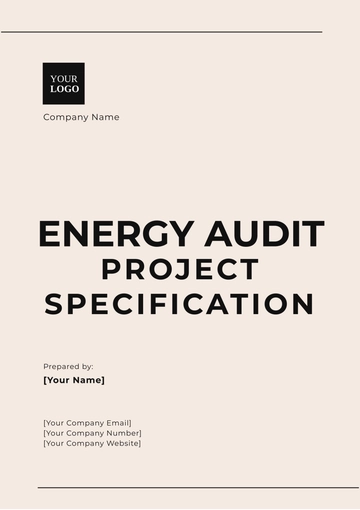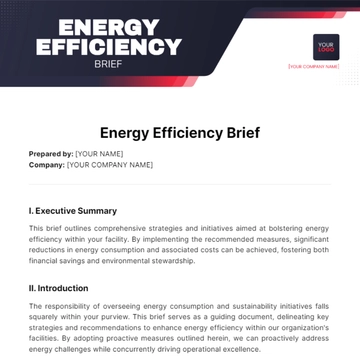Free Solar Energy Financial Model

1. Introduction
The Solar Energy Financial Model is a crucial instrument designed for investors, developers, and other stakeholders involved in the renewable energy sector. With the global commitment to reducing carbon emissions and transitioning to cleaner energy sources, understanding the financial implications of solar energy projects is becoming increasingly important. By 2050, global demand for renewable energy is projected to surge, and solar energy is expected to play a pivotal role in meeting this rising demand. This document provides a detailed overview of the key components, assumptions, financial projections, and risk assessments associated with solar energy projects.
The financial model aims to serve not just as a financial calculator but as a comprehensive tool that can guide strategic decision-making throughout the project lifecycle. The development of solar energy projects requires careful planning, accurate data, and an understanding of market dynamics to ensure success.
2. Objectives of the Financial Model
The Solar Energy Financial Model has several objectives that serve to enhance the understanding and management of solar energy projects.
2.1. Financial Viability Assessment
The model provides a thorough assessment of the expected cash flows, profitability, and overall return on investment (ROI) of solar projects. By calculating key performance indicators (KPIs), stakeholders can make informed decisions regarding project feasibility.
2.2. Investment Decision Support
By analyzing various financial metrics—such as net present value (NPV), internal rate of return (IRR), and payback period—the model assists investors in making informed decisions about capital allocation for solar energy projects. These metrics are essential for comparing different investment opportunities.
2.3. Risk Analysis
The financial model incorporates comprehensive risk assessments that help identify potential pitfalls and uncertainties that may affect project outcomes. This proactive approach allows stakeholders to develop strategies to mitigate risks, enhancing project stability.
2.4. Policy and Incentive Evaluation
Understanding how various governmental policies and incentives impact the overall financial performance of solar energy projects is critical. The model evaluates the benefits of tax credits, rebates, and other financial incentives, enabling stakeholders to optimize their financing strategies.
2.5. Market Analysis and Forecasting
By analyzing market trends and forecasts, the financial model helps stakeholders anticipate future energy prices, demand, and regulatory changes. This information can be invaluable for strategic planning and decision-making.
3. Key Components of the Financial Model
The Solar Energy Financial Model consists of several key components that outline the assumptions and calculations necessary for analyzing a solar project. Each component contributes to a comprehensive understanding of the project's financial landscape.
3.1. Project Costs
Understanding the total costs associated with the development and operation of a solar energy project is essential. These costs can be categorized into capital expenditures (CapEx) and operating expenditures (OpEx).
3.1.1. Capital Expenditures (CapEx)
Capital expenditures refer to the upfront costs incurred during the development of the project. These costs typically include:
Cost Category | Description | Estimated Cost ($) |
|---|---|---|
Land Acquisition | Cost of purchasing or leasing land | 500,000 |
Solar Panels | Cost of purchasing solar photovoltaic panels | 1,000,000 |
Inverters | Cost of purchasing inverters | 300,000 |
Installation | Labor and materials for installation | 500,000 |
Permitting and Licensing | Costs for obtaining necessary permits | 100,000 |
Miscellaneous Expenses | Contingency costs and additional fees | 150,000 |
Total CapEx | 2,600,000 |
The above table provides a clear overview of the initial investment required for the project, highlighting the importance of thorough budgeting in the planning stage.
3.1.2. Operating Expenditures (OpEx)
Operating expenditures are the ongoing costs associated with running and maintaining the solar project. These costs typically include:
Cost Category | Description | Estimated Cost ($) |
|---|---|---|
Maintenance | Routine maintenance and repairs | 50,000 |
Insurance | Insurance coverage for the project | 30,000 |
Administrative Expenses | Administrative costs related to project management | 20,000 |
Utility Fees | Fees for connection to the grid | 10,000 |
Miscellaneous Expenses | Additional ongoing expenses | 5,000 |
Total OpEx (Annual) | 115,000 |
The total operating expenditures reflect the ongoing costs necessary to maintain the solar project’s functionality and efficiency.
3.2. Revenue Generation
The financial model must account for the various revenue streams generated by the solar project. The primary sources of revenue typically include energy sales, renewable energy certificates (RECs), and potential government incentives.
3.2.1. Energy Sales
The primary revenue source for solar energy projects comes from selling electricity generated by the solar panels to the grid or directly to consumers.
For example, if a solar project generates [1,500,000] kWh annually and the selling price is [$0.10] per kWh:
Annual Revenue from Energy Sales = [1,500,000] x [$0.10] = [$150,000]
3.2.2. Renewable Energy Certificates (RECs)
In addition to energy sales, solar projects can earn revenue from Renewable Energy Certificates (RECs), which represent the environmental benefits of generating renewable energy. The price for RECs can vary, but for this model, we will assume a value of [$15] per REC. If the project generates [1,500] RECs annually, the revenue from RECs would be [$22,500].
3.2.3. Government Incentives
Many governments provide incentives to promote renewable energy. These can take the form of grants, tax credits, or feed-in tariffs, which can significantly enhance a project's revenue stream. For this model, we will estimate government incentives at [$30,000] annually.
3.2.4. Total Revenue
The total revenue from the project can be summarized in the following table:
Revenue Source | Annual Revenue ($) |
|---|---|
Energy Sales | 150,000 |
Renewable Energy Certificates | 22,500 |
Government Incentives | 30,000 |
Total Revenue | 202,500 |
This total revenue figure demonstrates the comprehensive income generated by the project, highlighting the importance of diverse revenue streams in ensuring financial viability.
3.3. Financing Structure
The financing structure for solar projects often involves a combination of equity and debt. Understanding the financing costs is essential for evaluating the financial feasibility of the project.
3.3.1. Equity Financing
Equity financing involves raising capital by selling shares in the project. Typically, investors require a return on equity (ROE) of around [8%] to [12%]. For our model, we will assume an equity investment of [$1,500,000]. This equity investment can come from individual investors, venture capitalists, or institutional investors.
3.3.2. Debt Financing
Debt financing usually comes from loans or bonds. The cost of debt is determined by the interest rate on the loan, which can vary based on market conditions and the creditworthiness of the project. For this model, we will assume a loan amount of [$1,100,000] with an interest rate of [5%].
3.3.3. Annual Debt Service
The annual debt service, which includes both principal and interest payments, is [$55,000].
3.3.4. Financing Structure Summary
A summary of the financing structure for the project can be presented in the table below:
Financing Source | Amount ($) | Percentage of Total Financing (%) |
|---|---|---|
Equity Financing | 1,500,000 | 57.69 |
Debt Financing | 1,100,000 | 42.31 |
Total Financing | 2,600,000 | 100 |
This table highlights the balance between equity and debt financing in the project, essential for understanding capital structure.
3.4. Financial Metrics
To evaluate the financial performance of the solar energy project, various metrics are calculated. These metrics provide insights into the profitability and sustainability of the project.
3.4.1. Net Present Value (NPV)
The NPV calculates the present value of future cash flows, discounted at a specified rate. It is a crucial indicator of the project's profitability.
Assuming an annual cash flow of [$202,500] for [25] years, the NPV calculation will provide insights into the long-term value of the project.
3.4.2. Internal Rate of Return (IRR)
The IRR is the discount rate that makes the NPV of all cash flows from the project equal to zero. It represents the expected annual rate of growth the project is anticipated to generate. A higher IRR indicates a more attractive investment opportunity.
3.4.3. Payback Period
The payback period measures how long it takes for the project to repay its initial investment through generated cash flows. A shorter payback period is generally preferred as it indicates a quicker return on investment.
This metric indicates that the project will take approximately [13] years to pay back the initial investment, which is within a reasonable timeframe for solar projects.
3.5. Sensitivity Analysis
A sensitivity analysis is critical in assessing how changes in key assumptions impact project outcomes. This analysis allows stakeholders to evaluate how variations in energy prices, operational costs, and financing terms affect financial metrics such as NPV and IRR.
3.5.1. Scenario Analysis
Various scenarios can be developed to analyze different market conditions. For instance:
Scenario | Energy Price ($/kWh) | NPV ($) | IRR (%) |
|---|---|---|---|
Base Case | 0.10 | 1,000,000 | 10 |
Optimistic Scenario | 0.12 | 1,300,000 | 12 |
Pessimistic Scenario | 0.08 | 700,000 | 8 |
This table summarizes how changes in energy prices can significantly affect NPV and IRR, helping stakeholders prepare for market fluctuations.
4. Risk Assessment
Understanding the risks associated with solar energy projects is vital for successful implementation. The financial model includes a thorough risk assessment that identifies and evaluates various risk factors.
4.1. Regulatory Risks
Regulatory risks are associated with changes in government policies, incentives, and regulations related to renewable energy. The financial model considers potential impacts of policy changes, including tax credits and tariffs.
4.2. Market Risks
Market risks encompass fluctuations in energy prices and demand for electricity. These risks can significantly impact revenue generation. The model includes scenarios to analyze how changes in energy prices could affect overall profitability, enabling stakeholders to develop contingency plans.
4.3. Technology Risks
Rapid advancements in solar technology may lead to obsolescence of existing systems. The model considers potential impacts on performance and operational costs, ensuring that stakeholders are prepared for technological changes that could affect project efficiency.
4.4. Financing Risks
The availability and terms of financing can substantially influence project costs and returns. The model incorporates sensitivity analyses to evaluate the impacts of changing interest rates or equity returns on financial metrics. Understanding these risks is crucial for managing financial stability.
4.5. Operational Risks
Operational risks encompass issues related to project performance, including equipment failure, maintenance challenges, and unexpected costs. The model includes contingency plans to mitigate these risks, ensuring that the project remains resilient against unforeseen challenges.
4.6. Environmental Risks
Environmental risks include potential adverse impacts on local ecosystems and compliance with environmental regulations. The model assesses these risks, enabling stakeholders to implement measures to minimize environmental impact and adhere to regulatory requirements.
5. Conclusion
The Solar Energy Financial Model serves as a comprehensive framework for evaluating the financial viability of solar energy projects. By understanding the key components, financial metrics, and associated risks, stakeholders can make informed decisions regarding investments in solar energy. As we move towards 2050, the importance of renewable energy will continue to grow, and developing robust financial models will be essential for realizing the full potential of solar power.
5.1. Future Outlook
The future of solar energy appears promising, with technological advancements driving down costs and increasing efficiency. Policymakers and investors must work together to create supportive environments for solar projects, ensuring their long-term sustainability and success. The Solar Energy Financial Model will continue to evolve, adapting to new market conditions and technologies, ensuring it remains a vital tool for stakeholders in the renewable energy sector.
5.2. Call to Action
Investors, policymakers, and developers should leverage the insights provided by the Solar Energy Financial Model to drive growth in the solar energy sector. By collaborating and investing in renewable energy, stakeholders can contribute to a sustainable future for generations to come.
5.3. Additional Resources
For further information and resources related to solar energy financial modeling, stakeholders can explore the following:
Industry reports on solar market trends and forecasts.
Software tools for financial modeling and analysis.
Government websites providing information on solar energy incentives and policies.
- 100% Customizable, free editor
- Access 1 Million+ Templates, photo’s & graphics
- Download or share as a template
- Click and replace photos, graphics, text, backgrounds
- Resize, crop, AI write & more
- Access advanced editor
Plan your financial strategy with the Solar Energy Financial Model Template from Template.net. This editable and customizable template assists you in projecting revenues, costs, and cash flows for solar projects. Use our Ai Editor Tool to personalize it, ensuring accurate financial planning and analysis.











